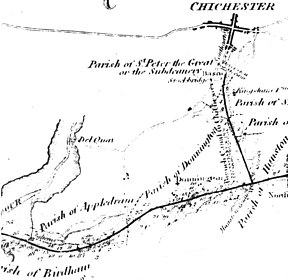Chichester Canal
| Chichester Canal | |
|---|---|

A map of the planned route of the canal from 1815
|
|
| Specifications | |
| Maximum boat length | 85 ft 0 in (25.91 m) |
| Maximum boat beam | 18 ft 0 in (5.49 m) |
| Locks | 2 |
| Status | part navigable |
| Navigation authority | West Sussex County Council |
| History | |
| Date of act | 1819 |
| Date of first use | 1822 |
| Date closed | 1928 |
| Date restored | 1984 |
| Geography | |
| Start point | Chichester |
| End point | Chichester Harbour |
The Chichester Canal is a navigable canal in England. It runs 4.5 miles (7.2 km) from the sea at Birdham on Chichester Harbour to Chichester through two locks. The canal (originally part of the Portsmouth and Arundel Canal) was opened in 1822 having taken three years to build. When completed the canal could take ships of up to 100 tons. Dimensions were limited to 85 feet (26 m) long 18 feet (5.5 m) wide and a draft of up to 7 feet (2.1 m).
Proposals for a canal linking Chichester directly to the sea go back as least as far as 1585 when an act of parliament was passed allowing a cut linking Chichester with the sea. Further proposals were made in the early 19th century, with schemes being proposed in 1801, 1802, 1803 and 1811, but none of these came to pass and as a result the first link to the sea was via a branch of the Portsmouth and Arundel Canal opened in 1822. In 1817 it had been decided that the section between Chichester and Chichester Harbour, unlike the rest of the canal, would be built large enough to carry boats of 100 tons. Putting this into practice required a new act of parliament which was obtained in 1819. In the same year the construction of the Chichester branch began. During the construction of the basin a hoard of 300 Denarii was found. The section of the canal that would become the Chichester Canal was formally opened on 9 April 1822
The Portsmouth and Arundel Canal was conceived as part of a bigger plan to provide a secure inland canal route from London to Portsmouth, but by the time the route was completed, the war with France had ended. With the reason for its construction removed, the canal was not a commercial success, and apart from the Chichester section, it had fallen into disuse by 1847.
The canal was transferred to the Corporation of Chichester in 1892. In November of that year the City Surveyor gave a figure of £1000 to put the canal back into full working order. Work required included the repair of locks bridges and the removal of weeds and mud from the channel. By 1898 only 704 tons of goods were carried and tolls for the year stood at £18. The last recorded commercial traffic was in 1906 when a load of shingle was carried from Chichester Harbour to the basin at Southgate. In the same year it was found that the swing bridges at Donnington and Birdham needed to be repaired or replaced. Westhampnett Rural District Council wanted to replace them with fixed bridges (which would have blocked the canal) but the Corporation of Chichester wanted to keep the canal open to traffic. By 1923 the Corporation appears to have accepted that there would be no further traffic and allowed the swing bridges to be replaced by fixed bridges.
...
Wikipedia
